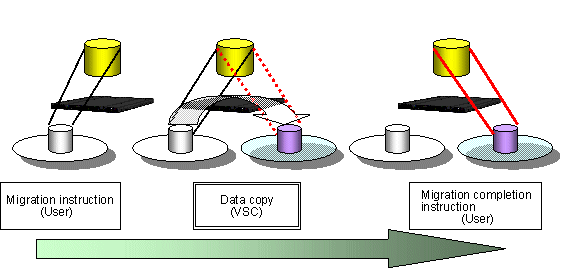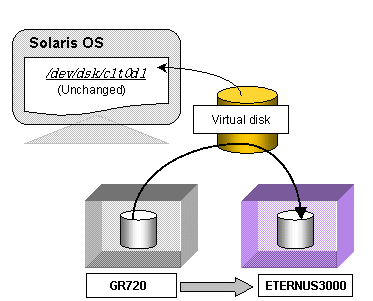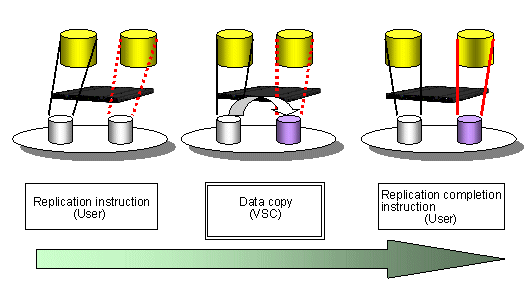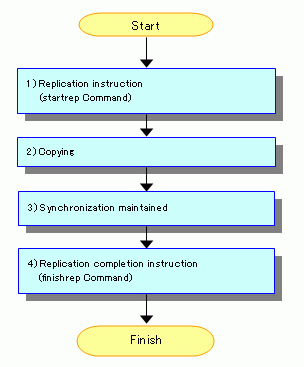VSC provides the server-free data service function, which copies data using the resources of the virtualization switch without using the resources (CPU and memory) of the transaction server. Originally, the resources of a transaction server should be consumed by an application that processes data, but not by such secondary tasks as backup and maintenance. The use of this function allows you to use transaction server capabilities more effectively.
This service provides the following functions:
Migration function
Replication function
The migration function moves data in a physical disk to another physical disk of virtual disk. This function can be used to migrate data to a new disk unit or remove a physical disk that is causing a performance bottleneck.
You do not need to change the disk information (WWNs and disk numbers) recognized by the transaction server. Instead, VSC automatically changes the information of physical disks that make up a virtual disk(s).
After copying data to a destination physical disk, there are two options: allowing VSC to automatically switch the physical disks or having the user manually switch the disks. When migration is activated in a mode that retains no backup disk, VSC automatically switches the physical disks (using an automatic switching function). When migration is activated in a mode that retains a backup disk, the user must manually switch the physical disks.
When choosing not to use the automatic switching function, the user must issue an instruction to switch the physical disks. This instruction, to switch the physical disks, is called a migration completion instruction. Upon receiving a migration completion instruction from the user, VSC writes the data passed from an application to both the migration source and destination physical disks in order to maintain synchronization between both disks. Therefore, be sure to issue a migration completion instruction at the appropriate time to avoid adversely affecting virtualization switch capability.

Target | Status | Access enabled? | Remarks |
|---|---|---|---|
Source physical disk | Copying | Yes | - |
Synchronization maintained | Yes | - | |
Switching complete | - | - | |
Destination physical disk | Copying | - | - |
Synchronization maintained | - | Execute a write request on the virtualization switch to maintain synchronization. | |
Switching complete | Yes | - |
VSC provides migration operation with the following characteristics:
Migration with non-stop server operation
Generally, an application or the system must be restarted when a transaction server uses the destination disk. With a virtual disk, however, the transaction server only recognizes the information on the virtual configuration, while VSC keeps track of all information on the physical configuration of the virtual disk (such as physical disk information). Therefore, the transaction server need not recognize any change made to the connected disk. Even if a change is made to the migration destination physical disk, you can continue using the disk without having to stop the system or application.

Saving the data of the migration source
Migration is generally intended to upgrade a disk unit (or renew a device for storing data) so that you will no longer need the physical disk that was used before migration. Once migration is performed, significant changes are made to the system environment, such as installation of a new disk unit that may possibly cause unexpected trouble. Therefore, you must save the information before migration and keep it ready for reuse in order to prepare for quick recovery.
Since VSC continues to retain the backup disk until the user issues an instruction to delete it, promptly delete the disk after issuing a migration completion instruction.
Note
In migration to hold migration backup disk (hereinafter called "backup disk"), if you want to ensure data consistency stored on backup disks, it is required to write data cached on the application server to the backup disks before migration cutover to ensure the consistency.
Note that if you do not directly specify a destination physical disk, VSC automatically chooses a physical disk for you. Therefore, you must manually create a virtual storage pool using only the destination physical disk.
Moreover, the virtualization switch that performs copy processing must retain access paths to both the migration source and destination physical disks.
When VSC accepts a migration instruction, it returns a session ID to you. Use the session ID for a migration completion instruction or migration cancellation instruction.
The replication function creates a copy of a virtual disk. This function can be used to build a new transaction or make a backup copy of a virtual disk.
You must issue instructions to start and end a replication process. VSC writes data passed from an application to both the migration source and destination virtual disks in order to maintain synchronization between both disks.

Target | Status | Access enabled? | Remarks |
|---|---|---|---|
Source virtual disk | Copying | Yes | - |
Synchronization maintained | Yes | - | |
Switching complete | Yes | - | |
Destination virtual disk | Copying | No | An access error occurs. |
Synchronization maintained | No | An access error occurs. | |
Switching complete | Yes | - |
Replication is executable by the startrep command from the operations management server or using the ETERNUS SF AdvancedCopy Manager.
The replication executed with the ETERNUS SF AdvancedCopy Manager includes a function to suspend and resume copy. However, note that the replication executed by the commands from the operations management server does not include the function to suspend and resume copy.
For replications performed using the startrep command on the operations management server
a. There are no functions for suspending or resuming copies.
b. The copy security function cannot be used.
For replications performed using ETERNUS SF AdvancedCopy Manager
a. There are functions for suspending and resuming copies.
b. The copy security function can be used.
Refer to “3.4.3 Copy security function” for more information about copy security.
See
For replications using the ETERNUS SF AdvancedCopy Manager, refer to "ETERNUS SF AdvancedCopy Manager Operator's Guide".
For details of commands from the operations management server, refer to "Appendix B Admin Server Commands".
The following are descriptions of a flow of replications from start through end using the commands from the operations management server.

Replication start directions (startrep command)
Use the startrep command from the operations management server to start replication.
Information
Information required for replication directions includes the name of a replication-source virtual disk and the name of a replication-destination virtual disk.
During copy
Data on its source virtual disk is being copied to its destination virtual disk. If you want to abort replication, use the cancelrep command from the operations management server.
Equivalency maintain status
This is a status that the same data is written on its source virtual disk and on its destination virtual disk. If you want to abort replication, use the cancelrep command from the operations management server.
Replication finish directions (finishrep command)
Using the finishrep command from the operations management server, cancel the equivalency maintain status of the source virtual disk and the destination virtual disk to finish replication.
Note
An access error occurs if the destination virtual disk is accessed during replication. Make sure that the transaction server does not access the virtual disk during use of the replication function.